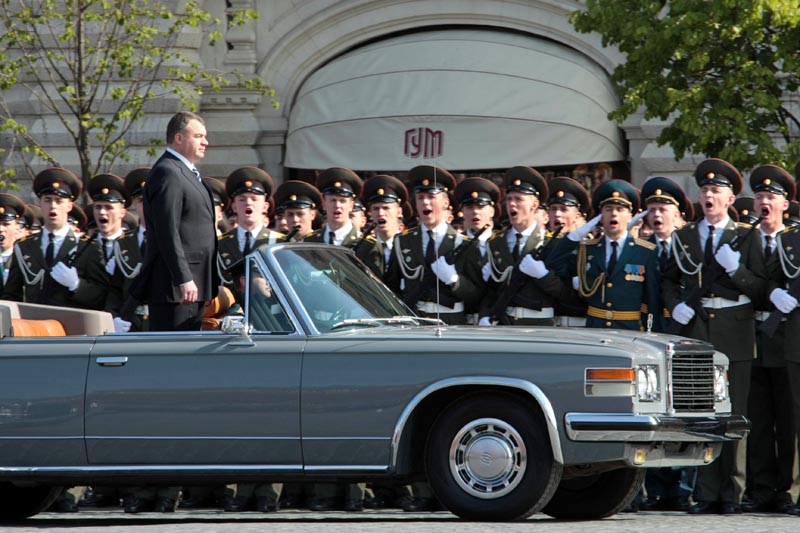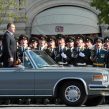
The Bear, the Abacus and Impossible Defense Computations
Publication: Eurasia Daily Monitor Volume: 8 Issue: 56
By:

The expanded session of the Russian defense ministry collegium on March 18, given the crisis in reforming the armed forces, promised to be a crucial test for Defense Minister, Anatoliy Serdyukov, and there were numerous signals that a vintage performance might be on offer. Earlier in the week, Serdyukov granted an exclusive interview to Viktor Litovkin published on March 18, in Nezavisimoye Voyennoye Obozreniye. However, the interview deliberately avoided discussing the wider reform issues, in order to allow Serdyukov to elaborate on the golden social protection promises for the military being so liberally extended in election year (https://nvo.ng.ru/realty/2011-03-18/1_serdyukov.html, March 18).
Serdyukov’s favorite themes were predictably aired in the public part of the defense ministry collegium and the promised increases in officer pay and pensions featured prominently. However, the defense minister gave new meaning to “voodoo economics,” the phrase coined by former US President George H. W. Bush. Characterizing the reform as entering a “new stage” Serdyukov insisted that the modernization of the equipment and weapons will achieve its set target of 70 percent new by 2020, which few believe can be realistic due to the condition of the domestic defense industry. Serdyukov also gave an upbeat assessment of the current level of “new” equipment and weapons, which Serdyukov stated has reached 15 percent (https://www.kremlin.ru/news/10677, March 18).
Here the voodoo begins to work its magic, unfortunately Serdyukov either ignored or was unaware of the statement three days earlier by Colonel-General Aleksander Postnikov, the Commander-in-Chief of the Ground Forces, who told the Federation Council’s Committee on Defense and Security that the present level of “new” is 12 percent. Of course, Serdyukov has little respect for serving officers, but given that Vedomosti had characterized Postnikov as one of the “import generals” based on his support for buying abroad, it is surprising that the defense minister did not pay closer attention (Vedomosti, March 18; Nezavisimoye Voyennoye Obozreniye, March 16). The discrepency may be accounted for in the gap between official reporting on the progress of the modernization and its real level.
The failure in February to send three satellites into orbit for the GLONASS system prompted Deputy Prime Minister, Sergei Ivanov to ask “where is the insurance?” The silence was deafening. As a result of a “childish mistake” the loss was estimated at 2.5 billion rubles ($88.2 million). Last month, Serdyukov was asked to explain the reasons as to why the State Defense Order (Gosudarstvennyi Oboronnyi Zakaz –GOZ) for 2010 was not fully implemented: he made no reference to these failures during his reported comments to the collegium. Corruption, secrecy, the lack of any coherent or transparent pricing system, bedevils a defense industry characterized by Major-General (retired) Vladimir Dvorkin as “morally and physically obsolete” (Ogonek, March 14).
General Postnikov said the armed forces will experience constant change annually to 2020 and confirmed that the brigade model now centers on three different types: heavy, medium (multirole) and light. Heavy brigades would be equipped with tanks and armored vehicles weighing up to 65 tons; old tank platforms will be replaced with modern versions while the medium brigades would feature armored vehicles still being designed. Light brigades, may be equipped with Tiger vehicles and could be used in mountainous or Arctic terrain. A special brigade will be formed for use in the Arctic based in Pachenga, Murmansk. Much media coverage focused on Postnikov saying that domestically produced hardware, such as the newest T-90 tank (the 17th modification to the Soviet T-72), is inferior to NATO and Chinese standards, and strongly recommended procuring abroad. His comparison of the cost of one T-90 (118 million rubles –$4.14 million) matching three German-built Leopards was an exaggeration intended as a damning indictment of the Russian defense industry. He also highlighted the need to shorten existing courses for professional non-commissioned officers from 34 months to ten months and spoke of developing 42 “future type” brigades (Interfax, March 15).
Postnikov’s selection of the tank issue could equally well be applied to other types of domestic defense produce. Some critics dismiss his views as merely representing an effort to promote the interests of the Ground Forces. Yet, he makes an important point, if the modernization results in “new” tanks appearing in the armed forces that are of inferior quality to NATO or Chinese standards is this merely a symbolic modernization or are the top brass resigned to the “new look” proving to be a display of declining Russian hardware standards? Postnikov links the reform to the pursuit of network-centric warfare capabilities and the need to retrain officers; he understands that the era of tank-centric warfare has been displaced (https://newsru.com/russia/15mar2011/postnikov.html).
Like other commanders, Postnikov calls for increased numbers of contract servicemen, knowing that the modernization would be pointless if the armed forces continue relying on conscripts serving for twelve months. Serdyukov said in February that the Security Council was working on the issue, and he told the defense ministry collegium that President Dmitry Medvedev has approved the number of officers at 220,000 and contract personnel numbers will rise to 425,000 (https://www.kremlin.ru/news/10677, RIA Novosti, March 18). This figure appears randomly chosen, probably linked to the level of “one million” men under arms also set by the Security Council, but there was no detail on how these may be recruited, or how the kontraktniki could be transformed into genuinely professional personnel. If these are recruited from among the conscripts, it is likely to fail like the previous federally targeted program.
Serdyukov’s lack of respect or understanding of officers partly explains his capacity to underestimate the timescale needed to reform the officer corps. He famously stated at the outset of the reform that the officer corps structure was egg-shaped, bloated in the middle, and required radical downsizing. The officer corps has in effect been downsized from an ostrich to a goose egg. Setting impossible and arbitrarily chosen figures or targets for the reform limits its potential success. Painting by numbers cannot be compared with a real work of art, and the “reform” which is only a loose set of disjointed reform aspirations, suffers from a lack of focus on raising quality. Serdyukov will inspire little confidence among officers by his ill-fated attempts to talk up the achievements of the reform. The abacus may need to be handed to a defense minister who insists on setting realistic targets.




